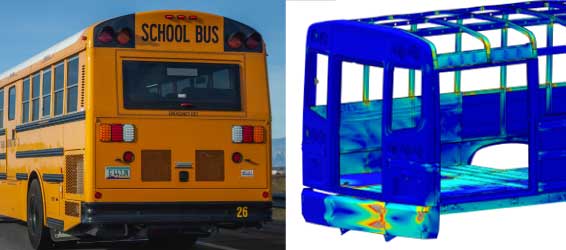Key results:
1. Large-scale models in FEA / Full-scale models
2. Post-failure analysis
3. Multiple load cases
In order to certify vehicles to be roadworthy in the USA, companies need to pass FMVSS standardized testing. To pass these standardized tests companies must fabricate the prototype of the vehicle, which can cost a lot of money without knowing if it’s going to pass or not.
For this study, school buses are subjected to the FMVSS222 standard test. This test is studying the wheelchair anchor pulling caused by a simulated frontal and rear impact. Force is applied to the wheelchair anchors while the structure of the vehicle is fixed. For the test to pass anchors must still be attached to the structure of the vehicle at the end of the test.
Main challenges:
1. Large-scale model
2. Post-failure behaviour of fasteners
3. Non-linear behaviour of the structure
4. Multiple scenarios
Before fabrication of the prototype, Optimec has modelled the full-scale model of the vehicle in FEA using Simulia in the 3DEXPERIENCE platform. To capture the highly non-linear response of the structure of the vehicle, the Abaqus/Explicit solver is used while respecting the quasi-static nature of the testing by monitoring the inertial effects of the vehicle.
To have a more realistic simulation fastener failure was included in this analysis to better predict the post-failure response of the structure. Fasteners such as rivets, bolts and outriggers were modelled using Abaqus connectors.
Using FEM as a design tool enables the customer to make several design changes based on the simulation results. These changes could then be validated using the same FEM tool before any physical prototypes were ever built.
Design changes consisted of fastener relocation/addition, the addition of structural support and material changes. These design changes enabled the customer to move forward with their design with confidence.

